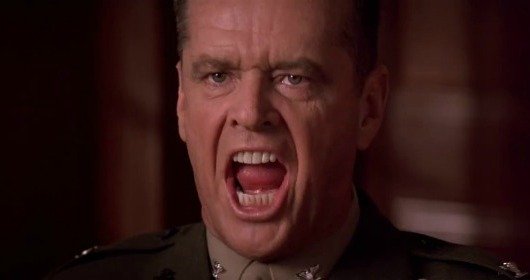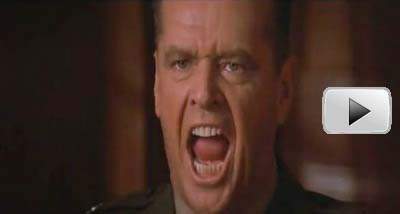And it has the power to get your screenplay tossed, instead of read.
How do you write an effective dialogue, a dialogue that REALLY contributes to your story?
Simple.
Make sure it fulfills the 5 movie dialogue functions.

A lot has been said and written about the functions of dialogue.
And there are different opinions on how many there are, and what they are.
We wanted to know the "truth" about them. So we looked for someone who had a track records in that domain.
Meet Colonel Jessep from the screenplay "A Few Good Men", written by Aaron Sorkin.
He became famous with his line: "You cannot handle the truth".
Whatascript!:
Colonel, what is according to you the purpose of dialogue in a script?
Col. Jessep:
In the screenplay, like in the film, I am in the business of saving lives.
I take actions to provide freedom. These actions show what I do.
The movie dialogue, and I mean by that, what I say and what I don't say, tells you why I did what I did and the meaning of what happened.
Whatascript!:
Colonel, some people say movie dialogue has 4 functions, some others say 7 ...
Col. Jessep:
Son, there are 5 movie dialogue functions, period.
| The 5 movie dialogue functions | ||||||||||||||||||||
| ||||||||||||||||||||
Whatascript!:
Colonel, does that mean that any dialogue should fulfill one of these functions?
Col. Jessep:
Yes, at least one. Potentially more.
Sometimes when I speak I have one movie dialogue function in mind. Sometimes 2 or 3 - with one function being predominant.
And sometimes I speak in such a way that I fulfill all the 5 movie dialogue functions at the same time.
Whatascript!:
Colonel, can you give us an example of this multifunctional use?
Col. Jessep:
The climax scene at the end of the script with this Navy Lawyer Lieutenant-Smartass guy who pins me on a technicality.
In that scene I fulfill all 5 movie dialogue functions. I bring conflict, character, information, emotions, and move the story forward.

Whatascript!:
I see. Could you elaborate on the first movie dialogue function, moving the story forward?
Col. Jessep:
I'd appreciate it if you addressed me as Colonel or Sir. I believe I've earned it.
Whatascript!:
Colonel, could you elaborate on the first function?
Col. Jessep:
No problem, son. I'm here to help anyway I can.
Whatascript!:
Thank you.
Col. Jessep:
You believe that, don't you? son? That I'm here to help anyway I can?
Whatascript!:
Of course.
Col. Jessep:
I'll answer all your questions. But you have to ask me nicely.
Whatascript!:
Colonel Jessep... if it's not too much trouble, could you elaborate on the first movie dialogue function? and move this interview ... uh ... forward?
Col. Jessep:
No problem, son.
If your words stop the action, do not add anything to the story or do not have the plot in mind, then you do NOT move the story forward.
I never did that.
Considering the fact I used to eat breakfast 80 yards away from 4000 Cubans who were trained to kill me, I had neither the time nor the inclination to chit chat or not to be focused on my mission.
Whatascript!:
Colonel, could you give us an example of the application of this first movie dialogue function?
Col. Jessep:
You may recall when Jo and Danny ...
Whatascript!:
You mean Commander Jo Galloway and lieutenant Kaffee, Colonel?
Col. Jessep:
Yes, as I said, when Jo and Dany came to see me at Guantanamo Bay to find out about the incident with young William ...
Whatascript!:
You mean the death of PFC Santiago, Colonel?
Col. Jessep:
Son! Don't ever interrupt me again. I don't have time to repeat myself. Now if that's a source of problem for you, well, I don't give a shit.
So, like I said, in that meeting:
And all of what I say moves the action forward.
JO (to JESSEP) I was wondering if you've ever heard the term Code Red. KAFFEE Jo -- JESSEP I've heard the term, yes. JO Colonel, this past February, you received a cautionary memo from the Naval Investigative Service, warning that the practice of enlisted men disciplining their own wasn't to be condoned by officers. JESSEP I submit to you that whoever wrote that memo has never served on the working end of a Soviet-made Cuban Ml-Al6 Assault Rifle. However, the directive having come from the NIS, I gave it its due attention. What's your point, Jo? KAFFEE She has no point. She often has no point. It's part of her charm. We're outta here. Thank you. JO My point is that I think code reds still go on down here. Do Code Reds still happen on this base, colonel? KAFFEE Jo, the colonel doesn't need to answer that. JO Yes he does. KAFFEE No, he really doesn't. JO Yeah, he really does. Colonel? JESSEP You know it just hit me. She outranks you, Danny.
Whatascript!:
Colonel, have you ever heard the term "on the nose" dialogue?
Col. Jessep:
I've heard the term, yes... That's a characteristic of weak characters.
I submit to you that they have never served on the working end of a Soviet-made Cuban Ml-Al6 Assault Rifle. They do not live in the urgency. They just chit-chat, say what they do, and express what they feel the way it is. All the time. No subtext. No creativity. No nothing. Just a flat dialogue.
They might as well go to Dialogueville and jump off the "Nose" rock.
Whatascript!:
Do you have any recommendation for the screenwriters who are at the source of such flat dialogues, colonel?
Col. Jessep:
Maybe -- and I'm just spit balling here -- but maybe writers have a responsibility to their audience that their characters charged with its entertainment are trained to speak properly.
Get these screenwriters to study:
Get the lads to practice all of them.
Like if the lives of their characters was at stake. Truth of the matter is ... they are.


You may not realize it but by taking this simple action you
empower us to write more articles like that - one Comment/Like/Share at a time.
Thanks for that.
It's all about Revealing Character.
Pictures and screenplay extracts:
"A Few Good Men" - Jack Nicholson (Colonel Jessep), Tom Cruise (Lt Kaffee); Aaron Sorkin (screenplay), Rob Reiner (director), Robert Richardson (director of photography), Columbia Pictures and Castle Rock Entertainment
Go from 5 movie dialogue functions (part 1) to Home page
* Gladiator, written by David Franzoni, revised by John Logan